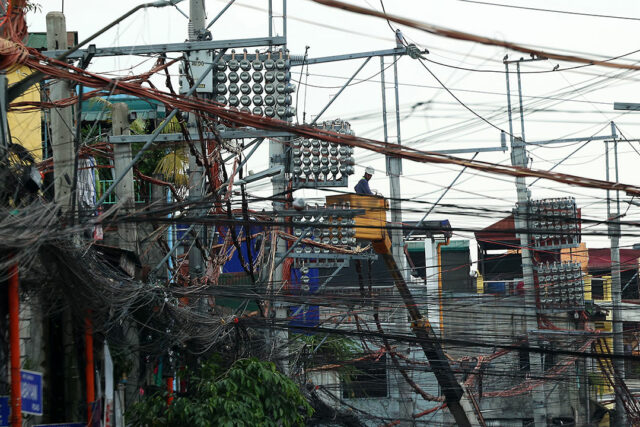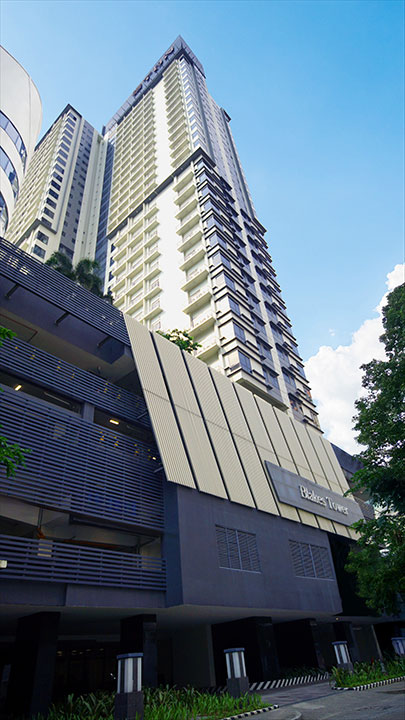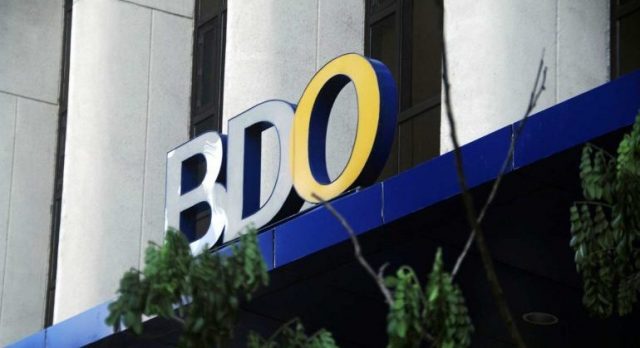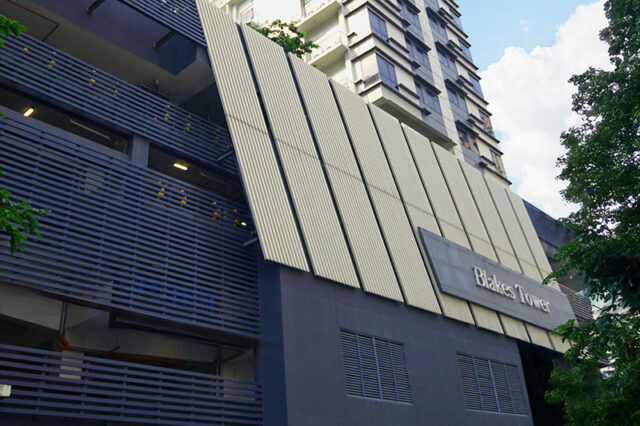Mouthwash may cure ‘the clap’
PARIS — In the 19th century, before the advent of antibiotics, Listerine mouthwash was marketed as a cure for gonorrhoea. More than 100 years later, researchers said Tuesday the claim may be true.
Banks’ bad loan ratio eases in June

By Katherine K. Chan
THE Philippine banking sector’s nonperforming loan (NPL) ratio dropped to a three-month low in June even as banks continued to expand their lending portfolios, Bangko Sentral ng Pilipinas (BSP) data showed.
Data from the BSP showed banks’ gross NPL ratio eased to 3.34% in June from 3.38% in May, and 3.51% in the same month last year.
This was the lowest NPL ratio in three months or since the 3.3% in March.
Loans are considered nonperforming once they are unpaid for at least 90 days after the due date. These are deemed as risk assets since borrowers are unlikely to pay.
The amount of nonperforming loans inched up by 0.5% to P530.29 billion in June from P527.45 billion in May. Soured loans also jumped by 5.5% year on year from P502.42 billion.
The total loan portfolio of the banking system stood at P15.88 trillion as of end-June, up by 1.69% from P15.62 trillion at end-May and up by 10.9% from P14.32 trillion a year ago.
Reinielle Matt M. Erece, an economist at Oikonomia Advisory and Research, Inc., said the impact of policy rate cuts are starting to spill over to bank lending rates.
“We have seen lower interest rates which may make it easier for borrowers to repay their obligations,” he said.
The central bank has so far lowered borrowing costs by a total of 125 basis points (bps) since it began its easing cycle in August last year. In June, the Monetary Board cut by 25 bps to bring the benchmark rate to 5.25%.
“The slight easing in the NPL ratio may reflect stable borrower repayment capacity, supported by low inflation, steady employment, and still-resilient domestic demand,” John Paolo R. Rivera, a senior research fellow at the Philippine Institute for Development Studies, said in a Viber message.
Mr. Rivera also attributed the softening ratio to universal and commercial banks’ tighter lending policies.
“However, a larger reason for the NPL easing is the significant increase in loan volume for the month which grew by about 12% year on year,” Mr. Erece said. “This caused the ratio of nonperforming loans to overall loans to decrease as the denominator increased significantly.”
Meanwhile, past due loans increased by 1.75% to P670.5 billion in June from P659 billion in May. Year on year, it went up by 9.17% from P614.17 billion.
Past due loans as of June accounted for 4.22% of the system’s total loan portfolio, unchanged from end-May but lower than the 4.29% a year ago.
Restructured loans, on the other hand, slipped by 0.44% to P312.03 billion in June from P313.39 billion in May, but rose by 6.27% from P293.62 billion in June 2024.
It took up less of the industry’s total loan portfolio at 1.96% from 2.01% in the previous month and 2.05% in the same period last year.
Banks’ loan loss reserves edged up by 1.42% to P505.91 billion in June from P498.83 billion in May and by 5.5% from P479.46 billion a year earlier.
Loan loss reserve ratio in June was unchanged from May at 3.19%, but lower than the 3.35% in the same month in 2024.
Meanwhile, lenders’ NPL coverage ratio, which gauges the allowance for potential losses due to bad loans, inched up to 95.4% from 94.57% in May. Year on year, it slipped from 95.43%.
“A policy rate cut later this month could lower borrowing costs, encourage loan growth, and help more borrowers service their debt,” Mr. Rivera said.
BSP Governor Eli M. Remolona, Jr. said a rate cut is “quite likely” at the Monetary Board’s next meeting on Aug. 28.
“However, faster credit expansion also means banks will need to manage credit risks carefully to prevent a rebound in NPLs,” Mr. Rivera said.
Mr. Erece, on the other hand, said banks’ bad loan ratio may continue to narrow in the next few months.
“Apart from the expected impacts of rate cuts, we may also expect a rise in borrowing brought by the end of the year spending,” he said.
2026 budget proposal heads to Congress for deliberation

By Kenneth Christiane L. Basilio, Reporter
LAWMAKERS should avoid compromising the proposed P6.793-trillion national budget for next year through congressional insertions, which could undermine the Philippines’ fiscal consolidation efforts and hamper growth prospects, analysts said on Tuesday.
President Ferdinand R. Marcos, Jr. on Tuesday received a copy of the 2026 National Expenditure Program (NEP) from Budget Secretary Amenah F. Pangandaman during a ceremonial turnover at Malacañan Palace.
The record P6.793-trillion spending plan for 2026 will be formally submitted to Congress today (Aug. 13). It is 7.4% higher than this year’s national budget, and is equivalent to 22% of the country’s gross domestic product (GDP).
With the theme “Agenda for Prosperity: Nurturing Future-Ready Generations to Achieve the Full Potential of the Nation,” the Palace said next year’s budget “will build on the solid foundations laid over the past three years of (Mr. Marcos’) administration.”
John Paolo R. Rivera, a senior research fellow at the Philippine Institute for Development Studies, said the 2026 budget will be pivotal in funding the Marcos administration’s priorities at the midpoint of his six-year term and is critical to keeping the reform agenda on track.
“A well-prioritized budget can spur infrastructure, social protection and job creation. But if questionable insertions divert funds from high-impact projects, they could dilute growth momentum and make fiscal targets harder to hit,” he said in a Viber message.
“Any misallocation at this point could slow the country’s trajectory and make catching up in the last two years far more difficult,” he added.
Next year’s budget is expected to face more public scrutiny after the 2025 national budget was hit with allegations of fund diversions, blank line items by the Executive and concerns over outsized public works allocations.
In his State of the Nation Address, Mr. Marcos warned Congress that he will not sign any General Appropriations Act (GAA) that is “not fully aligned” with the NEP.
“I am willing to do this even if we end up with a reenacted budget,” Mr. Marcos said.
However, Ms. Pangandaman earlier told BusinessWorld that a reenacted budget would hurt the economy and will force the government to fund projects that are not aligned with its 2026 plans.
“The 2026 budget will be pivotal because it’s the main vehicle for translating the administration’s growth and fiscal consolidation goals into concrete programs,” Mr. Rivera said.
The government is targeting 5.5-6.5% GDP growth this year, and 6-7% growth from 2026 to 2028. It also aims to bring down the debt-to-GDP ratio to 60.4% by the end of 2025, and to 56.9% by 2028.
Next year’s spending plan will also be key to how the Marcos administration navigates risks from shifting global trade dynamics, such as the US tariff policies, said Reinielle Matt M. Erece, an economist at Oikonomia Advisory and Research, Inc.
The US began to impose higher tariffs on most of its trading partners starting Aug. 7. A 19% tariff was slapped on goods from the Philippines, Indonesia, Cambodia, Malaysia and Thailand.
“The 2026 budget and how it is utilized will describe how the administration manages the economy through harsher economic conditions, especially as trade wars may continue to persist and investor sentiment may continue to be affected by it,” he said in a Viber message.
AJ A. Montesa, advisor at budget watchdog People’s Budget Coalition, said congressional insertions in the proposed national budget may redirect funds away from key administration priorities, channeling it toward lawmakers’ own interests.
“Congressional insertions represent political self-interest outweighing the public good,” he said in a Viber message.
“A single congressman doing it may be or seem harmless, but as a whole, congressional insertions can create an inefficient budget misaligned with long-term national needs,” he added.
The Marcos administration is prioritizing infrastructure, industry development, food security and climate resilience in its spending plan for next year, according to a Budget department briefer on the proposed 2026 spending plan.
The government should increase spending on health, social, education and agriculture, which are seen as “high-yield, high-multiplier and job-generating” sectors, Jose Enrique “Sonny” A. Africa, executive director at think tank IBON Foundation, said in a Viber message.
“The reorientation to more social spending immediately improves people’s lives while generating demand, creating jobs and pressing structural change,” he said.
While the national budget has grown annually, Mr. Africa noted that funding for sectors such as health and education has declined as a share of GDP, raising concerns over the government’s spending priorities.
“The fall in social spending as a share of GDP between 2024 and 2025 has to be reversed — health spending drops from 1.4% of GDP to some 1.1%, education from 4.4% to 4.3%, and social security, welfare and employment from 2% to 1.2%,” he said.
He added that more support should be extended to Philippine businesses, including subsidies, to help spur domestic industrialization. “The government needs to start on a more active domestic industrialization policy.”
“The new budget must target productivity and social well-being to keep the country in its growth path and faster economic activity,” said Mr. Erece.
Jonathan L. Ravelas, a senior adviser at Reyes Tacandong & Co., said in a Viber message, said the government must reconsider its no-new tax policy and weigh fresh revenue measures and improve revenue collections, as the proposed budget increase could exert additional fiscal pressure,
“The 7.4% increase adds fiscal pressure, especially with limited revenue levers,” he said, adding that it’s only sustainable if state spending is “laser-focused” on government priorities.
“The problem with expenditures in the past three years is that its level is as if we are still in a pandemic,” Luis F. Dumlao, an economics professor at the Ateneo de Manila University said in a Facebook chat. “It may be sustained within the next three years within this administration, but it won’t be beyond future administrations.” — with Chloe Mari A. Hufana
AI could boost Philippine economy by P1.8 trillion

By Beatriz Marie D. Cruz, Reporter
ARTIFICIAL INTELLIGENCE (AI) technologies can potentially boost the Philippine economy by P1.8 trillion (around $31 billion), as Filipinos increasingly use AI for work and upskilling, according to a report by Google Philippines and consulting firm Public First.
If realized, this would result in a 7% increase in gross value added (GVA), and can possibly “lift our overall global standing,” Google and Public First said in its 2025 Economic Opportunity Report.
“With this new technology, it’s as if we’re adding a new growth engine, a new industry to the Philippines,” Gabriel Roxas, country marketing manager at Google Philippines and Vietnam, said at a news briefing on Tuesday.
The skills gained from AI can boost an average worker’s productivity by P110,000 a year (about $2,000), according to the report.
Today’s AI technologies could potentially augment around 37% of workers, it added.
It could also save the average worker around three hours worth of administrative tasks in a week, freeing up their time for more productive and high-value chores, it said.
This would also boost workers’ wages by over 6%, according to the report.
To unlock the economic benefits of AI, companies must develop new workflows and invest in the necessary infrastructure to accelerate AI adoption in their operations, Mr. Roxas said.
“What’s even more significant is when artificial intelligence unlocks different kinds of services, products or businesses that aren’t even within the scope of what they’re currently doing, which is actually likely possible, because these are new frontiers or revenue streams that won’t be possible without the technology available,” he added.
AI should also be ingrained in accelerating economic development and growth, which would help accelerate scientific innovation and boost workers’ skills overall, he added.
Across the Philippines, AI adoption has been growing at a fast pace, driven by its young and mobile-first population.
In its report, Google and Public First noted that AI adoption is higher among the younger workforce, which bodes well for the Philippines as it has a median age of 26.
“We saw higher adoption rates among the younger workforce. So, that bodes well for us because these are people who are leaning into new technologies and eager to try it out,” Mr. Roxas said.
“We’ve gotten used to using smartphones, these devices for everyday productivity tasks,” he added. “All the more that it’s going to be easier to access artificial intelligence solutions on our mobile devices.”
AI can also boost productivity across traditional and emerging sectors, he said.
In particular, AI can help boost the growth of the wholesale and retail industry by P410 billion (about $7.2 billion), which is equivalent to a 9% increase in GVA.
Wholesale and retail companies could use AI to improve their advertising, and quickly respond to consumer queries and requests, Mr. Roxas said.
“Of course, and maybe this is what we can encourage our Filipino businesses to do, is that AI can open up new markets for you to export to, especially the markets where they have a different language,” Mr. Roxas said.
The financial and insurance sector can also grow by P300 billion (around $5.2 billion), increasing its GVA by 12%, if it adopts AI to create better product solutions and detect cases of fraud.
The report noted that AI can increase the GVA of the public administration and defense sector by 9%, reaping economic benefits of about P109 billion (around $1.9 billion).
“AI can streamline a lot of frontline services as well, in terms of actually optimizing procurement, identifying bottlenecks, and catching fraud. But ultimately, the end vision here is for governments to actually personalize how they interact and solve the problems of each citizen,” Mr. Roxas noted.
Greater digital access can increase the overall economic impact of AI in the Philippines by P37 billion, Google and Public First said, citing the importance of smartphones, connectivity, and digital infrastructure in achieving this.
AI can also address some of the country’s pressing issues, namely, cyberthreats and fraud, agriculture, and public sector challenges, Google and Public First said.
According to the report, AI-driven solutions can reduce about half of the costs (about P180 billion) arising from cybersecurity threats and fraud.
By 2035, AI could also boost the productivity of the Philippines’ agriculture sector by about P120 billion through satellite imagery, weather forecasts, and farm sensors.
Lastly, AI tools can increase the efficiency of the public sector by 5% by streamlining repetitive tasks, the report said.
“With artificial intelligence, you can automate highly repetitive tasks, so that the manpower of the government can focus on much more pressing issues,” Mr. Roxas noted.
The report, which included a survey of over 1,084 online adults based in the Philippines, said that 50% of respondents are using AI weekly in their personal lives.
It also noted that 76% of Filipino respondents said that they’re already using AI for work or intend to do so in the next 12 months.
“This tells us that it’s actually quite mainstream to leverage artificial intelligence,” Mr. Roxas said.
The Google and Public First survey noted that 87% of Filipinos have shown interest in using AI to learn a new skill.
This means they see AI as a partner or tutor that will help them make the most out of the available technologies, Mr. Roxas said.
About 88% of Filipinos are willing to engage in skills training to better take advantage of the benefits of AI, the report said.
With this, businesses and employees must meet halfway to find better ways to learn AI at a quicker pace, according to Mr. Roxas.
“What’s most important is for us is to come together as an ecosystem and as a community to drive education and learning. Because it’s not just about learning a technology, it’s about economic growth,” he said.
Meralco power rates climb in August

By Sheldeen Joy Talavera, Reporter
RESIDENTIAL HOUSEHOLDS in areas served by Manila Electric Co., (Meralco) will see higher electricity bills this month as the power distributor hikes rates due to higher generation and transmission charges.
The overall rate will increase by P0.6268 per kilowatt-hour (kWh) to P13.2703 per kWh in August from P12.6435 per kWh in July, the company said in a statement on Tuesday.
Households consuming 200 kWh will see an upward adjustment of around P125. Those consuming 300 kWh, 400 kWh, and 500 kWh will have to pay an additional P188, P251, and P313, respectively.
Meralco attributed the increase to the generation charge which rose by P0.3749 per kWh. Generation charge typically accounts for more than 50% of the electricity bill.
“The generation charge increased by 37 centavos per kilowatt-hour due to higher charges from independent power producers (IPPs) as well as the Wholesale Electricity Spot Market (WESM),” Meralco Vice-President and Head of Corporate Communications Joe R. Zaldarriaga said at a briefing.
Charges from IPPs climbed by P0.9476 per kWh, reflecting the weakening of the peso against the US dollar. Around 99% of IPP costs were dollar-denominated.
The peso closed at P58.32 on July 31, weakening by nearly P2 from its P56.33 finish on June 30.
“Because many of the costs of generation plants are denominated in dollars, such as fuel usage, the peso equivalent of their costs increased,” Lawrence S. Fernandez, vice-president and head of utility economics, said.
Mr. Fernandez said the company expects the peso-dollar exchange rate as a major factor that may affect power bills for September.
“So, we’ll have to monitor what the exchange rate will be until the end of the month,” he said.
WESM charges edged up by P0.4582 per kWh due to increase in average capacity on outage in the Luzon grid.
The increases in IPP and WESM charges were partly cushioned by the P0.2604 per kWh drop in charges from power supply agreements (PSAs). This was attributed to lower coal and liquified natural gas prices and improved delivery.
IPPs, WESM, and PSAs accounted for 25%, 7%, and 68%, respectively, of the power distributor’s total energy requirement for the period.
Contributing to higher electricity rate this month was the transmission charge, which rose by P0.1270 per kWh. The National Grid Corp. of the Philippines started the collection of under-recoveries equivalent to P0.0384 per kWh over 84 months, as approved by the Energy Regulatory Commission.
Other charges, including taxes, also increased by P0.1249 per kWh.
“Pass-through charges for generation and transmission are paid by Meralco to the power suppliers and the grid operator, respectively, while taxes, universal charges, and Feed-in Tariff Allowance are all remitted to the government,” the company said.
Meralco’s distribution charge remained unchanged since the P0.0360 per kWh in August 2022.
Meanwhile, consumers continue to benefit from Meralco’s refund of P0.2024 per kWh as part of ongoing implementation of the distribution-related true-up adjustment.
Meralco’s controlling stakeholder, Beacon Electric Asset Holdings, Inc., is partly owned by PLDT Inc. Hastings Holdings, Inc., a unit of PLDT Beneficial Trust Fund subsidiary MediaQuest Holdings, Inc., has an interest in BusinessWorld through the Philippine Star Group, which it controls.
PLDT’s Q2 profit climbs to P9.11B; CEO sees stronger second half

LISTED telecommunications company PLDT Inc. saw its attributable net income rise by 6.05% in the second quarter (Q2) to P9.11 billion compared to the same period last year, lifted by higher service revenues.
Combined revenues for the April-to-June period rose by 1.76% to P54.3 billion from P53.36 billion in the same period last year, according to PLDT’s latest final statement.
Broken down, service revenues accounted for the majority of the topline generated for the period at P52.89 billion from P51.25 billion in the comparable period a year ago; while non-service revenues declined by 33.18% to P1.41 billion from P2.11 billion previously.
For the January-to-June period, PLDT’s total revenues inched up by 1.85% to P109.57 billion from P107.58 billion.
Broken down, service revenues went up by 2.77% to P106.31 billion from P103.44 billion; while non-service revenue declined to P3.27 billion, marking a decrease of 21% from P4.14 billion.
For the first semester, PLDT’s attributable net income fell by 1.47% to P18.14 billion from P18.41 billion, as the company’s higher expenses for the period overtook the growth in revenues.
Telco core income, which excludes the impact of asset sales and gains from Maya Innovations Holdings — went down by 4.39% to P17.22 billion from P18.01 billion in the January-to-June period.
For the first half, PLDT’s share of profits from its digital bank Maya amounted to P406 million, turning around from a P1.1-billion loss during the same period last year.
“It should be better (in the) second half. I think the Maya performance would also be better in the second half… On telco core, it is probably flattish for the full year,” PLDT and Smart Communications, Inc. Chairman and Chief Executive Officer (CEO) Manuel V. Pangilinan said during a briefing.
For the first semester, PLDT’s combined expenses grew by 2% to P81.03 billion from P79.47 billion in the same period last year.
The company’s capital expenditure (capex) for the six-months ending June amounted to P27.4 billion, compared with P35.1 billion in the same period last year. With this, the company’s capital guidance is now lower at P63 billion from the initially announced P68 billion and P73 billion, citing favorable pricing and negotiated deals with vendors.
“Our results for the first half of 2025 show the resilience of our business and the strength of our people. We continue to invest in the future — expanding our network, enhancing customer experience, and driving innovation across our businesses. In a challenging environment, we remain committed to delivering value to our customers, shareholders, and the country,” Mr. Pangilinan said.
“As we look ahead, our focus is on strengthening our business so it can better serve the country’s progress. Every improvement we make — whether in efficiency, innovation, or coverage — is part of the larger work of empowering communities and supporting the Philippines’ growth in a fast-moving world,” he added.
At the local bourse on Tuesday, PLDT shares increased by P16, or 1.23%, to close at P1,315 apiece.
Hastings Holdings Inc., a unit of PLDT Beneficial Trust Fund subsidiary MediaQuest Holdings Inc., holds a majority stake in BusinessWorld through the Philippine Star Group. — Ashley Erika O. Jose
DoubleDragon to issue P10.9-B bonds at 7.7% next month
DOUBLEDRAGON CORP. (DD) aims to raise up to P10.9 billion through a retail bond offering next month, offering a 7.7% interest rate with maturities of 3.5 and 5.5 years.
The issue will come from the company’s bond program via shelf registration that was approved by the Securities and Exchange Commission last year, DD said in a regulatory filing on Tuesday.
DD said the bond offering secured the highest PRS Aaa credit rating from the Philippine Rating Services Corp. The rating is given to companies that have a “very strong” capacity to meet their financial commitments compared to other Philippine firms.
“This retail bond tranche was decided to be issued earlier to capitalize on the September 2025 issuance window during which the DD double-seven peso retail bond will be the only bond offering in the market,” DD said.
DD said its total equity now stands at P102 billion, with a net debt-to-equity ratio of 0.87x, led by its diversified hard asset portfolio and its Hotel101 condotel chain that is seen to become one of the major dollar inflow generators to the Philippine economy.
In May, DD unveiled the 700-room Hotel101-Roxas Boulevard in Pasay City, which is expected to generate P5.25 billion in revenue from unit sales.
Hotel101-Roxas Boulevard, located on a 1,790-square-meter (sq.m.) commercial lot, will begin construction in the second half, with completion seen by the second half of 2028.
Last month, DD announced that it had 1.5 million sq.m. of total gross floor area in its portfolio with the completion of the five-hectare CentralHub warehouse complex in Cebu.
CentralHub is a joint-venture company between DD and Jollibee Foods Corp.
DD shares improved by 3.57% or 33 centavos to P9.58 per share on Tuesday. — Revin Mikhael D. Ochave
SM Prime earmarks P7B for SM Megamall upgrade

SM PRIME HOLDINGS, INC. has allocated P7 billion for the phased redevelopment of SM Megamall in Mandaluyong City, aiming for full completion by 2029 to expand leasable space, enhance sustainability, and improve customer experience.
SM Megamall’s redevelopment will have a phased completion starting in 2027, SM Prime said in a statement on Tuesday.
With the redevelopment, SM Megamall will see the addition of 20,000 square meters (sq.m.) of gross leasable area, a new four-level basement parking facility with over 1,600 slots, expanded walkways and ceilings, and improved circulation through wider corridors and modernized vertical transport, the company said.
The redevelopment also features the introduction of nature-inspired architecture, improved mobility features, and energy-efficient systems, as well as the addition of themed retail zones and intuitive wayfinding to make the mall more accessible, it added.
Additional features include modernized cinemas in new locations, a new Megatrade Hall, a revamped food court, and renovated common areas and restrooms.
SM Megamall’s redevelopment will also come with new sustainability features such as a rainwater harvesting system with a 500-cubic-meter capacity to support water conservation, alongside mechanical system upgrades to reduce overall energy consumption, according to the company.
Solar panel installations are also under evaluation as part of SM Prime’s broader carbon reduction efforts.
SM Supermalls President Steven T. Tan earlier noted that SM Megamall continues to lead the company’s 88 malls in sales per square meter, with SM Mall of Asia coming in second.
“There’s a huge waiting list for spaces in SM Megamall,” he said.
Mr. Tan also expects higher foot traffic in SM Megamall with the addition of new leasable spaces following the redevelopment.
“To be able to increase your revenue, you therefore have to give more convenience to the public, and we acknowledge that. Therefore, it is a little bit painful to close a certain portion of SM Megamall because of the revenue that it generates, but we feel that this is a more sustainable development for the business in general,” he said.
“We have redevelopment lined up for the next five years, as well as the opening of new malls. We always assess the maturity of an existing mall if they are ready for expansion or redevelopment,” he added.
SM Prime shares rose by 2.38%, or 55 centavos, to P23.65 per share on Tuesday. — Revin Mikhael D. Ochave
Bank earnings rise 4% in 1st half
PHILIPPINE BANKS’ combined net income grew by 4.14% in the first half as both net interest and non-interest earnings increased year on year.
The banking industry’s net profit climbed to P198.14 billion in the six months through June from P190.26 billion a year ago, data from the Bangko Sentral ng Pilipinas (BSP) showed.
Universal and commercial banks’ combined net income was at P184.45 billion in the first semester, while the thrift bank group booked a P10.73-billion net profit and the rural and cooperative bank sector posted net earnings of P5.34 billion. Lastly, digital banks recorded a combined net loss of P2.38 billion.
Broken down, the banking industry’s net interest income climbed 11.7% year on year to P564.98 billion in the six-month period from P505.82 billion.
This came as interest income grew 9.84% to P800.86 billion from P729.14 billion, faster than the 5.37% increase in interest expense to P234.66 billion from P222.7 billion.
Meanwhile, non-interest income rose 14.59% to P119.74 billion from P104.49 billion the year prior.
This was mainly driven by the 236.16% surge in trading income to P46.86 billion from P13.94 billion a year ago. Fees and commissions income also increased 15.55% to P89.02 billion from P77.04 billion.
Higher net interest and non-interest earnings partly offset the increase in the sector’s expenses in the period. Banks’ non-interest expenses grew by 12.56% year on year to P384.03 billion in the first half from P341.19 billion.
This was due to increases in spending on compensation, taxes and licenses, fees and commissions, and other administrative expenses. Banks also recorded higher impairment losses and provisioning.
Analysts said lending growth continued to drive Philippine banks’ profitability in the first half.
“The continuous rate cutting, along with RRR (reserve requirement ratio) easing may have increased the volume of loans that banks can give out to borrowers. Instead of interest payments, the increased volume of loans may have contributed to the increased profitability of these banks,” said Reinielle Matt M. Erece, an economist at Oikonomia Advisory and Research, Inc.
“This is largely attributed to stronger loan growth of banks at more than 12% in recent months, easing NPL (nonperforming loan) ratio and some improvement in asset quality, some trading gains amid Federal Reserve and BSP rate cuts since the latter part of 2024 amid benign local inflation, some pickup in gross domestic growth… that fundamentally increased demand for banking products and services by businesses, industries, and other institutions that support some increase in banks’ net income,” Rizal Commercial Banking Corp. Chief Economist Michael L. Ricafort said.
Mr. Ricafort said RRR reductions since last year have infused more than P700 billion in liquidity into the financial system, which increased banks’ loanable and investible funds.
Jonathan L. Ravelas, senior adviser at Reyes Tacandong & Co., said banks’ shift towards consumer lending and better expense management also supported the industry’s income growth.
“Lower rates helped boost loan demand, while asset quality stayed stable,” he added.
The BSP has cut benchmark interest rates by a cumulative 125 basis points (bps) since it began its easing cycle in August 2024, with its latest move being a 25-bp reduction in June. It is widely expected to deliver another rate cut later this month.
Meanwhile, in March, the RRR of universal and commercial banks and nonbank financial institutions with quasi-banking functions was reduced by 200 bps to 5%. The ratio for digital banks was also lowered by 150 bps to 2.5%, while the RRR for thrift lenders was cut by 100 bps to 0%. Rural and cooperative banks’ RRR has been at zero since October.
Mr. Ravelas said Philippine banks are likely to remain profitable, although income growth may moderate.
“Rate cuts could squeeze margins, so volume-driven lending and efficiency will be key. Watch for how banks manage risk and scale consumer finance.”
ASSETS CONTINUE TO EXPAND
Separate BSP data showed that the Philippine banking industry’s assets expanded by 7.71% to P28.21 trillion as of June from P26.19 trillion in the comparable year-ago period.
This was also 3.48% higher than the P27.26 trillion logged as of May.
Banks’ assets are mainly supported by deposits, loans, and investments. These include cash and due from banks as well as interbank loans receivable (IBL) and reverse repurchase (RRP), net of allowances for credit losses.
According to central bank data, bulk of the Philippine banking system’s assets were held by universal and commercial banks at P26.4 trillion at end-June.
The banking sector’s combined net total loan portfolio inclusive of IBL and RRP grew 11.13% year on year to P15.38 trillion as of June from P13.84 trillion.
Net investments, or financial assets and equity investments in subsidiaries, stood at P8.38 trillion in the period, increasing 11.29% from P7.53 trillion a year prior.
Net real and other properties acquired went up 18.26% year on year to P129.38 billion from P109.4 billion.
Meanwhile, cash and due from banks dropped 19.63% to P2.21 trillion from P2.75 trillion.
On the other hand, the total liabilities of the banking system grew 7.29% to P24.71 trillion at end-June from P23.03 trillion a year ago.
The majority of banks’ liabilities were deposits, which increased 5.89% to P20.67 trillion in the period from P19.52 trillion a year prior.
Peso-denominated deposits stood at P17.15 trillion, while foreign currency deposits were at P3.52 trillion. — BVR with inputs from Katherine K. Chan
DMCI Mining subsidiary bags 25-year operating rights in Palawan
BERONG NICKEL Corp. (BNC), a subsidiary of DMCI Mining Corp., has secured a 25-year mineral production sharing agreement (MPSA) with the Department of Environment and Natural Resources (DENR) through the Mines and Geosciences Bureau (MGB) for its Long Point Nickel Project in Aborlan, Palawan.
In a statement on Tuesday, DMCI Mining said the MPSA, covering 2,177.34 hectares, was signed on Aug. 8.
The agreement grants BNC the exclusive right to explore, develop, and utilize mineral resources in the contract area, renewable for another 25 years upon MGB registration.
“This MPSA is not just about resource development. It’s about creating shared value with our stakeholders by generating sustainable livelihoods, protecting the environment, and contributing to the local economy,” BNC President Tulsi Das C. Reyes said.
The company said it has poured P1 billion since 2024 into fleet expansion, port infrastructure, exploration, and pre-operating expenses.
It also secured an environmental compliance certificate for an annual production capacity of 1 million wet metric tons (WMT).
Operations are targeted to start by the fourth quarter of 2025, generating over 1,000 jobs, with priority given to residents and indigenous peoples, according to the company.
The company said it has also launched an Operators and Drivers Training Program in partnership with the Technical Education and Skills Development Authority.
In its Quezon mine, BNC has implemented its Final Mine Rehabilitation and Decommissioning Plan, covering 16.7 hectares of progressive rehabilitation and planting over 163,000 seedlings, 1,700 mangroves, and releasing 54 sea turtles, it noted.
The Quezon mine operated from 2006 to 2021, producing 10.4 million WMT of nickel ore, generating more than 1,600 jobs, and contributing about P2.8 billion to the economy, according to the company.
DMCI Mining operates in Palawan and Zambales and markets nickel ore to China and Japan. It is primarily engaged in exploring, extracting, and exporting nickel ore.
DMCI Mining holds a 74.80% effective interest in BNC, with the remaining 25.2% stake owned by Atlas Consolidated Mining and Development Corp. — Kyle Aristophere T. Atienza
BDO likely to sustain record profit, CEO says
BDO UNIBANK, Inc., the Philippines’ biggest lender, expects to sustain record-high earnings this year on broad-based growth in lending, its chief executive said, easing investor worries over the impact of US tariffs.
“It’s not ideal, it’s not what we want but we can live with it,” BDO Chief Executive Officer (CEO) Nestor V. Tan said on US tariffs in an interview with Bloomberg Television’s Haslinda Amin on Tuesday. “I don’t think the banking sector will be affected that much. Of course there may be a slowdown.”
Washington began imposing this month a 19% tariff on Philippine goods, on par with most of its neighbors.
BDO, owned by the family of late billionaire Henry Sy, Sr. reported a net income of P40.6 billion ($710 million) in the first half of the year, up 3% from a year ago. Profit rose 12% to a record P82 billion for all of 2024.
Shares of BDO, among the heavyweights in the benchmark Philippine Stock Exchange index, edged higher after falling as much as 2.1% earlier Tuesday. The stock has dropped 1.4% this year.
Mr. Tan said a stable geopolitical situation and macroeconomic indicators will be key for the Philippines to attract investors. He expects BDO’s revenues to grow by low double-digit levels this year.
“There are two things that we’re looking at. Number one is stability and we’re seeing that slowly happening. Second is probably a more benign interest rate environment,” the bank executive said. He expects the Bangko Sentral ng Pilipinas to further cut its key interest rate twice for the rest of the year.
“It impacts our margin negatively because the yields are expected to go down a few basis points,” Mr. Tan said. “But we’re hoping that with lower interest rates, capital expenditure lending will start to pick up, and that we hope the volume will offset for the margin compression.”
The bank last month raised P115 billion from a 1.5-year bond, the Southeast Asian nation’s largest corporate bond sale. Mr. Tan said it’s part of the bank’s funding mix “and when we expect rates to go down, we try to keep our liability short.” He sees the bank returning to the bond market next year.
The government is targeting lower economic growth of 5.5% to 6.5% this year compared with a previous goal of as much as 8%. Bangko Sentral ng Pilipinas Governor Eli M. Remolona, Jr. has said the monetary authority has room to continue its easing cycle next year after possibly two more quarter-point cuts for the rest of 2025. — Bloomberg
Art imitates Filipino life: MSMEs take spotlight in BSP exhibit
FROM the local wet market to neighborhood eateries, the Bangko Sentral ng Pilipinas’ (BSP) latest art exhibit shines a spotlight on the heart of Philippine businesses — the micro, small, and medium enterprises (MSMEs).
The Kultura. Kapital. Kasalukuyan: Contemporary Art from the BSP Collection exhibition, which opens on Aug. 14, is housed in two galleries at the National Museum of Fine Arts in Manila.
It features a collection of 36 contemporary art pieces, ranging from paintings and sculptures to mixed media works.
The display captures daily Filipino life, dreams, and struggles. It is anchored by the presence of National and contemporary artists whose works embody themes central to many MSME narratives.
“The exhibit, a collaboration between the BSP and the National Museum of the Philippines, is organized into two thematic streams across Galleries 18 and 19,” the BSP said in a statement.
“It is a narrative of evolving social movements and contemporary trends, revealing how culture and shared values transform, mirroring a creative landscape that is always in flux.”
Galleries 18 and 19 mirror the Filipino value of “pagtanaw” (to view or see), with pieces that examine past realities and offer insights into emerging themes.
It explores artistic expressions from the late 1980s to the 1990s when artists reclaimed their freedom to define identity, examine human conditions, and challenge inherited narratives, affirming art’s role as a critical discourse tool.
“Each one really complements each other and then highlights the whole point of the BSP collection,” John Paul Orallo, Museo BSP Bank Officer V, told reporters during the exhibit’s preview on Thursday last week. “But this is not just the BSP collection, this is the Filipino collection.”
Among the highlights are Nunelucio Alvarado’s 2009 Carinderia, showcasing a Filipino roadside eatery serving farmers, vendors, and laborers, and Emmanuel “Manny” Garibay’s Palengke from 2011 which captures the harsh reality of a crowded public market.
Complementing such contemporary voices are also religious paintings from the 18th century and portraits from the early 1990s.
“This is a very nice thing that we brought to the public. Because in the BSP, since we have limited space, we cannot really promote everything. And the themes here are really meant for a museum,” Mr. Orallo said.
Kultura. Kapital. Kasalukuyan: Contemporary Art from the BSP Collection is open for free to the public.
The exhibit’s purpose is reinforced by the central bank’s commitment to preserving and promoting Filipino heritage, linking art with the economic empowerment of the people.
The BSP’s extensive art collection stems from the legacy of former BSP Governor Jaime C. Laya, an avid art connoisseur who laid the foundation for the BSP’s renowned collection. — Katherine K. Chan
Eton Properties expands high-rise portfolio to 9,000 units with Blakes Tower launch

ETON Properties Philippines, Inc. (EPPI), the real estate arm of Lucio Tan Group, has launched Blakes Tower, a mixed-use development in Makati City.
Located along Malugay, Yakal, and Chino Roces streets in Makati City, Blakes Tower features 11 floors of modern office spaces and 15 residential floors with ready-for-occupancy units, the company said in a statement on Tuesday.
“Blakes Tower gives buyers the advantage of moving into their new home without the long wait. Located in a well-connected part of Makati, it offers the kind of convenience and quality that make settling in faster, easier, and more rewarding,” Eton Properties President and Chief Executive Officer Kyle C. Tan said.
“It’s a space designed for professionals, investors, and homebuyers who value accessibility, quality, and the opportunity to start enjoying their property sooner rather than later,” he added.
Following the launch of Blakes Tower, EPPI’s high-rise portfolio has reached 9,000 units across Metro Manila, the developer said.
EPPI posted a 24% increase in its first-quarter net income to P144 million from P116 million a year earlier.
Its leasing revenue remained flat at P473 million, while real estate sales reached P102 million, driven by remaining inventory projects like 68 Roces in Quezon City and Eton City in Laguna.
Shares of LT Group rose by 0.77% or 10 centavos to close at P13.10 apiece on Tuesday. — Beatriz Marie D. Cruz









